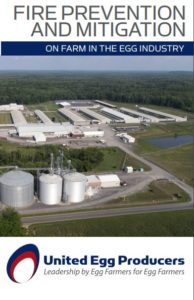February 3, 2022
Barn fires are horrific events, threatening both human and hen life and causing significant financial damage. Though the incidence of layer barn fires does not appear to be higher than those in other animal agriculture operations, they account for 94% of the animals lost.
they account for 94% of the animals lost.
In 2021, UEP assembled a task force of professionals to investigate and recommend best practices for preventing and mitigating barn fires. The task force released the Fire Prevention and Mitigation On Farm in the Egg Industry report during UEP meetings on January 24.
The report lists best practices for fire mitigation and prevention, including:
- Prepare a comprehensive Emergency Preparedness and Response Plan and ensure all appropriate staff are trained and prepared to follow the plan in the event of an emergency. Update the plan annually and immediately after renovations.
- Schedule regular meetings with local fire departments to educate responders about farm operations.
- Verify emergency signs are visible, accurate and maintained.
- Consult an insurance provider and an attorney to create a business continuity plan customized for a specific operation.
- Regularly train employees on the proper use of fire extinguishers. Have good quality, properly located extinguishers and a program to maintain them. Utilize a “hot work” program.
- Establish policies to keep combustible materials away from ignition sources.
- Follow good housekeeping and consider facility design adaptations for existing facilities.
- Use properly placed smoke or heat detection devices in non-barn structures and, when possible, use fire alarms in barns that do not cause panic among the hens.
- Use manure and manure belt management systems and practices known to minimize fire risks.
- When constructing new facilities, follow best design and construction practices that reduce or mitigate the risk of fire, including the distance between structures, firewalls, lighting, building design & materials, electrical housing and systems, ventilation, manure sheds and feed mills.
- Consider adopting advanced technology and methods, as appropriate for the operation, including new technology, infrared scanning, technology for extinguishing fires, and advanced materials at key points of combustion.
UEP’s VP of Animal Welfare, Dr. Larry Sadler, will continue to update the report as new technology and information become available.
 they account for 94% of the animals lost.
they account for 94% of the animals lost.